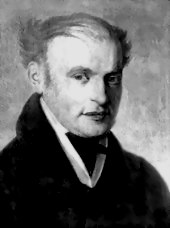Nikolaus Friedrich von Thouret
Nikolaus Friedrich Thouret , 1808 by Thouret , (* 2. June 1767 in Ludwigsburg , † 17th January 1845 in Stuttgart ) was a German architect and painter of Classicism . He was mainly active in Württemberg .
Life
His father Charles Ludwig Thouret (from Dole in Franche-Comté , 1724–1807) was the Duke of Württemberg valet under Carl Eugen , his mother Eva Christiana (1736–1815) a née Groz from Stuttgart-Plieningen . Thouret was trained as a court painter at the Hohen Karlsschule in Stuttgart from 1778 to 1788 . He then attended the Académie des beaux-arts in Paris from 1789–1790 . In Rome in 1793 he was inspired by Friedrich Weinbrenner , who was the same age , to study architecture .
In 1800 he became a ducal court architect ; he worked mainly under Duke Carl Eugen and King Friedrich I as an interior designer on numerous buildings and castles. From 1802, more and more agricultural master Carl Leonard von Uber developed into Thouret's rival . The conflict with Uber escalated in 1803 when Thouret submitted a resignation to King Frederick I that was subsequently rejected.
1808 Thouret was honored with the Knight's Cross of the Civil Merit Order , which was connected with the elevation to the personal nobility . In 1816, with the death of King Friedrich I, Thouret's activity as court architect ended.
In 1829, Thouret was given direct supervision of the newly founded K. Kunstschule , which was initially united with the Real- und Gewerbe-Schule , whereby he, as well as Johann Heinrich Dannecker , who presided over the top management of the art school, together with the Painters Eberhard von Wächter , Johann Friedrich Dieterich , Karl Jakob Theodor Leybold and Gottlob Friedrich Steinkopf the “art pupils” not only in “artistry, but also and perhaps even more in the formation of taste, the sharpening of the eye, the development, the animation and the correction of the artistic sense ”. Until the early 1840s, Thouret was entrusted with the board of directors of the art school, until the time when the commercial school as a polytechnical school developed from the spatially cramped shared accommodation in the so-called "officers pavilion" (built by Thouret in 1807) in Untere Königstrasse and the art school, together with the state art collections assigned to it for teaching purposes, moved into a new building, the old building of today's Stuttgart State Gallery .
In 1845 Thouret was buried in the Fangelsbach cemetery in Stuttgart-Süd .
Works


- 1796: Completion of the work on Hohenheim Castle, which Reinhard Ferdinand Heinrich Fischer began in 1785
- 1798–1800: On the recommendation of Johann Wolfgang von Goethe , he was called to Weimar to rebuild the Weimar City Palace, where he designed some rooms in a classical style
- 1800: Sigmundbrunnen, today on Wilhelmsplatz in Stuttgart
- Execution of the classical interior fittings
- 1805–1807: for the New Palace in Stuttgart
- 1804: for Monrepos Castle in Ludwigsburg
- for Solitude Palace (Stuttgart)
- Beginning of 1806: plan for the royal gardens between the New Stuttgart Palace and Cannstatter Strasse
- Execution of classical changes for the baroque Favorite Palace in Ludwigsburg
- 1808 to 1811: Construction of the St. Eberhard Cathedral in Stuttgart
- 1811–1812: Furnishings for the palace theater in the Ludwigsburg residential palace
- 1818: Fruit column as the landmark of the first Cannstatter Volksfest
- 1816: Four Medici vases in the marble hall of Ludwigsburg Palace
- 1820: Postplatz fountain on Rotebühlplatz in Stuttgart
- 1825–1826: Construction of the Great Kursaal in Cannstatt
- 1827: Katharinenhospital Stuttgart
- 1847: Graf-Eberhard-Bad (later Palais Thermal ) in Bad Wildbad
literature
- Paul Faerber: Nikolaus Friedrich von Thouret. A builder of classicism. Stuttgart: W. Kohlhammer Verlag, 1949.
- August Wintterlin: Thouret, Nikolaus Friedrich . In: Allgemeine Deutsche Biographie (ADB). Volume 38, Duncker & Humblot, Leipzig 1894, pp. 121-123.
- EJ Zeller: Stuttgart's private building from 1806 to 1844. In a selection given by master builder EJ Zeller. Stuttgart 1845–1846, first issue, plates 2–3, second issue, plates 6, 9, third issue, plates 6–7, 12.
Web links
Individual evidence
- ↑ Werner Gebhardt: The students of the High Charles School. A biographical lexicon . Stuttgart 2011, p. 525.
- ↑ Royal Württemberg Court and State Manual 1815 , p. 37.
- ↑ Wolfgang Kermer : Data and images on the history of the State Academy of Fine Arts Stuttgart . Stuttgart: Edition Cantz, 1988 (= improved reprint from: The State Academy of Fine Arts Stuttgart: a self-portrayal . Stuttgart: Edition Cantz, 1988), o. P. [4].
| personal data | |
|---|---|
| SURNAME | Thouret, Nikolaus Friedrich von |
| ALTERNATIVE NAMES | Thouret, Nikolaus Friedrich |
| BRIEF DESCRIPTION | German classicist painter, court architect |
| DATE OF BIRTH | June 2, 1767 |
| PLACE OF BIRTH | Ludwigsburg |
| DATE OF DEATH | January 17, 1845 |
| Place of death | Stuttgart |

